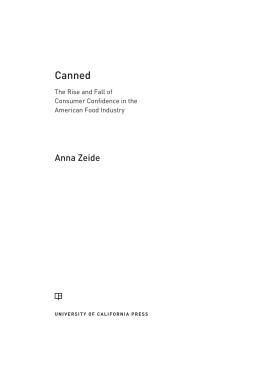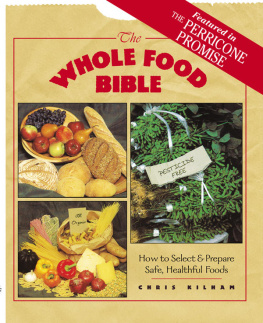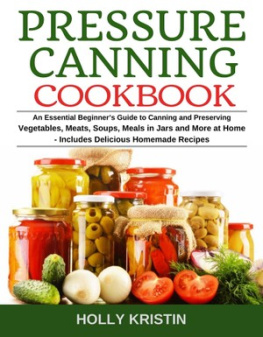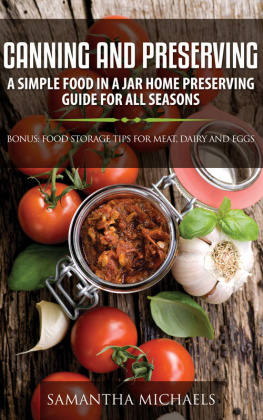Introduction
Canned food is not something most of us spend much time dwelling on. It occupies that corner of our pantry shelves, reached for unthinkingly on days when we want a quick meal or a simple ingredient. We may think of cans as a staple of food pantries or as ingredients in favorite childhood dishesCampbells tomato soup, green bean casserole, one-pot bean chili. We may imagine tin cans as part of stockpiles ready for the apocalypse. But wherever the can appears, it is typically in the background of our thoughts.
Canned food is also not something historians think much about. Larger, complicated technologies like the automobile or the electrical grid take center stage, while the mundane tin can recedes into the background.
But this book argues that the tin can and the sometimes mushy food inside deserve our full and rapt attention. Canned foodproduced in factories and packed in manufactured metal canshas played as significant a role in shaping our daily lives as have many more highly touted technologies, both directly and in the ways it laid the groundwork for other processed food. The invisibility of canned food is particular to our moment in time, when factory-produced foods of all forms surround us. think of cans as normal, or boring. There was a time, just over a century ago, when canned food seemed magical.
In a time when most Americans diets changed with the seasons and were limited by their geographic locations, cans opened up a whole new world of foods and flavors. For the first time, for many kinds of food, the offerings on the dinner table were not bound by the natural laws of decay. In the words of early canners: All the hoarded gifts of summer live in the can. Canned food put the June garden into the January pantry. As emphasized by the mythology that the canners created, canning made it possible for the juice of a summer peach to run down American chins in winter. Peas were no longer limited to a brief period in spring. Salmon from the Pacific Northwest could grace dinner tables in land-locked Arkansas. The idea that farmwives and fishermen could seal up food in one part of the year, only to eat it months or years later, when it was still edible and healthful, was revolutionary.
Still, when canned food began to appear on general store shelves, customers eyed the metal objects with equal parts awe and suspicion. Growing and buying food had always been a sensory experience, involving picking up food, smelling it, feeling it for ripeness. A savvy farmer or consumer could always identify a good tomato by the smell of its vine, the firmness of its flesh, the hue of its skin. Canned food broke that relationship, offering consumers only hard metal adorned by colorful paper. As historian Ann Vileisis writes, Before cans, foods were leafy and earthy with attached greens and clinging soil. They were odorous animals with ears, eyes, and tongues.... But cansbe they filled with salmon, dandelion greens, oysters, or tomatoeshad no swish or splash. The transitionfrom growing your own tomatoes to reaching for an opaque can of tomatoes packed in an unknown place by unknown handsdid not come easily, taking more than a century. And even when the unfamiliarity was no longer the central impediment, spoilage and overcooking often made canned food unappetizing or even frightening. Consumers had to develop a relationship of trust to these industrial products. Only then were they convinced to bring canned foods into their homes on a regular basis.
Early canners, the businessmen who used new technologies to convert the fruit of the field into the fruit of the factory, dedicated themselves to fostering trust in consumers. At first, they worked to perfect the technologies of the canning process, breed can-ready crops, and banish the bacteria that led to spoilage. All of this was done in the name of building a better product to gain consumer confidence. Later, as they became
The story of canned food offers crucial insight into understanding how and why Americans eat the way that we do. Many of us are familiar with contemporary conversations linking processed foods to obesity, and we see cases of foodborne illness splashed across the headlines, leading to ebbs and flows in the publics confidence. But, thinking historically, where did processed foods originate, what were their precursors, and how was public confidence in industrialized food earned in the first place? How did we come to accept and trust that these packages filled with foods of unknown origin and age would be worth eating?
Following the trail of processed food backward leads to canned food, in the early nineteenth century. It was the first nationally marketed, factory-processed, packaged food. Canning, along with meatpacking and grain processing, was the original technique of processing food, yielding a product that emerged from the factory in a form quite different from what you would find in nature or on the farm. Two characteristics distinguished canned food from meat and grain: one was the opaque metal container in which it was packaged; the other was the unfamiliar process by which it seemed to halt natures process of decomposition. Both of these factors made canned food a tough sell. The product and the process by which it was created were opaque to the average consumer, both literally and metaphorically. Before the spread of canning in the late nineteenth century, most Americans had just begun the shift away from eating foods that they either grew themselves or obtained locally. The foreign nature of canned goods, along with the industrys early difficulties in making its products safe and appealing, led to a lack of confidence among consumers and an early market that grew slowly.









